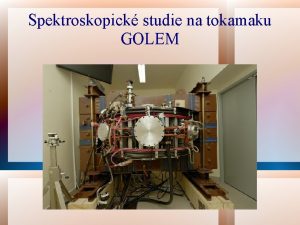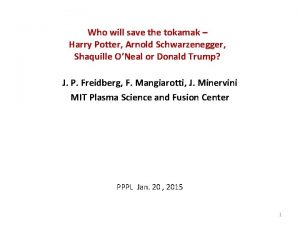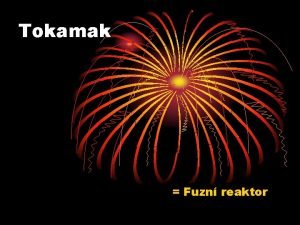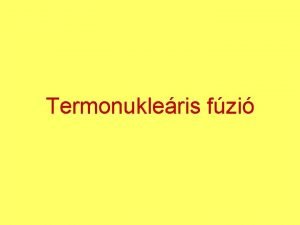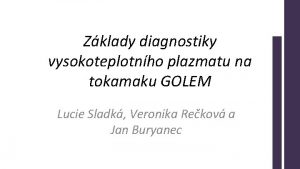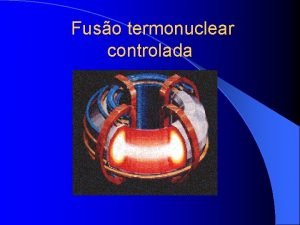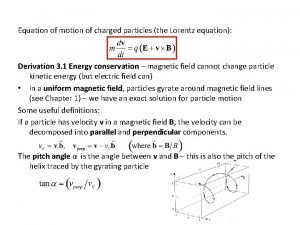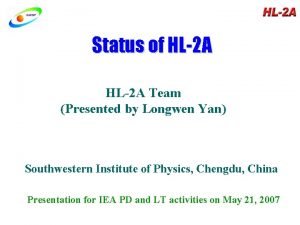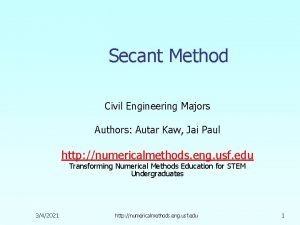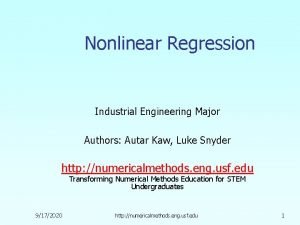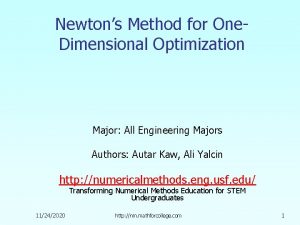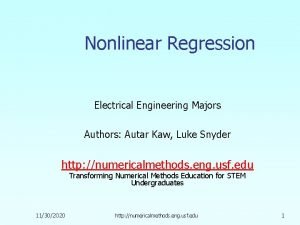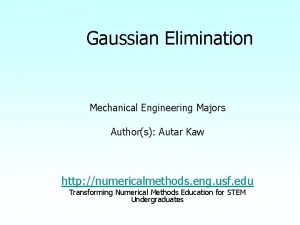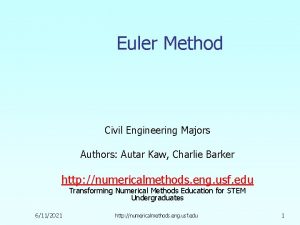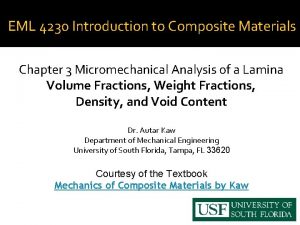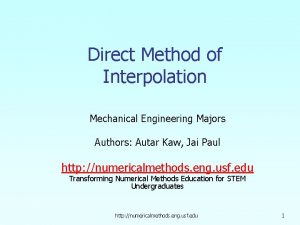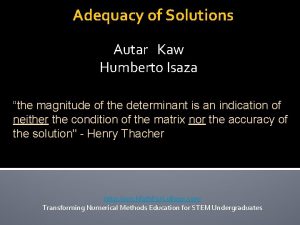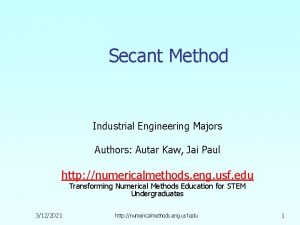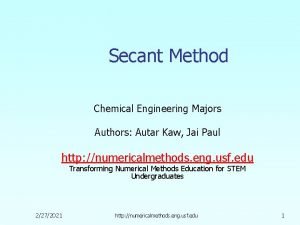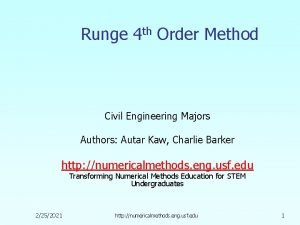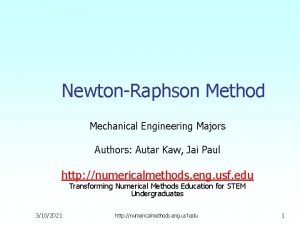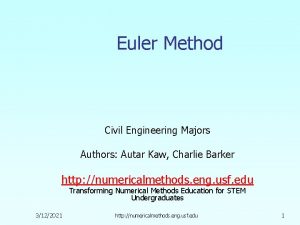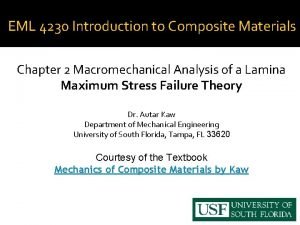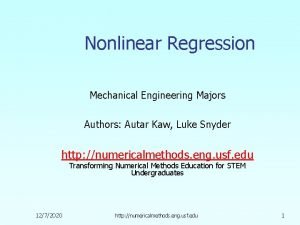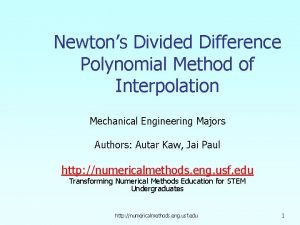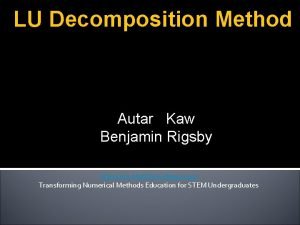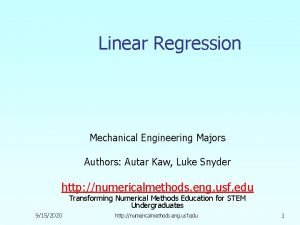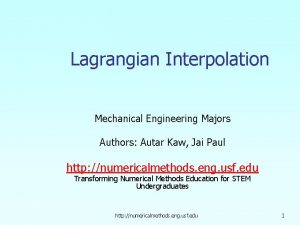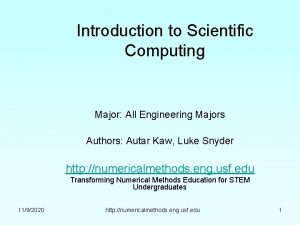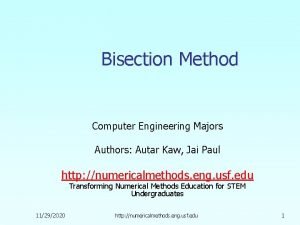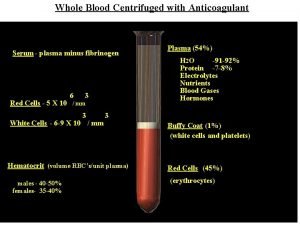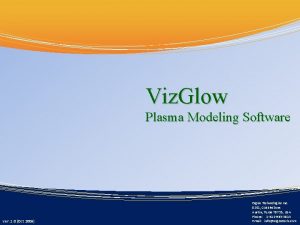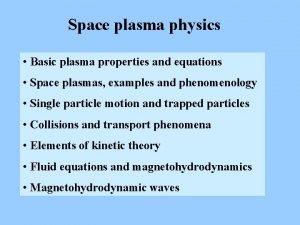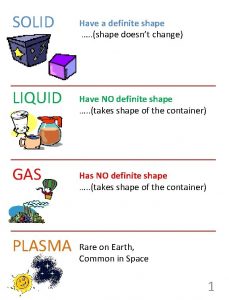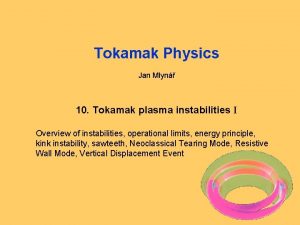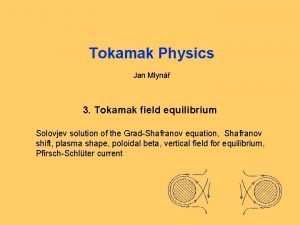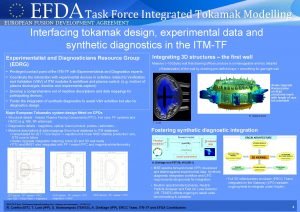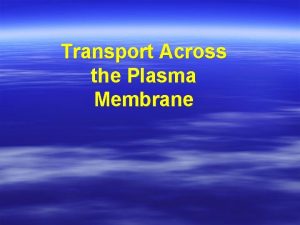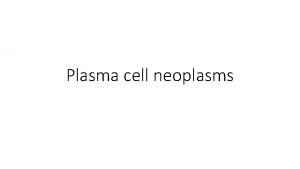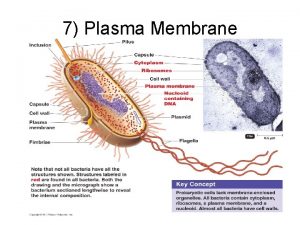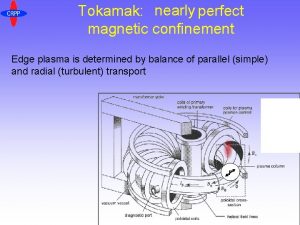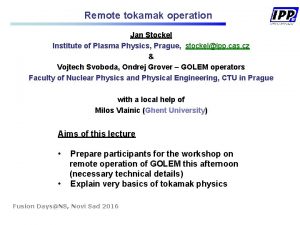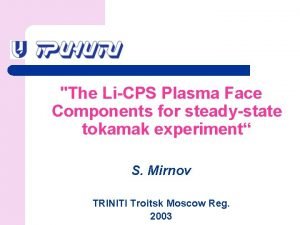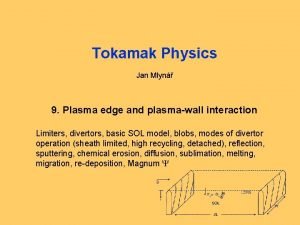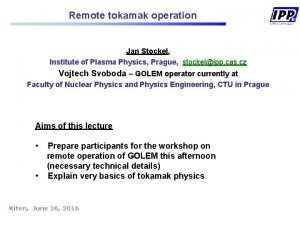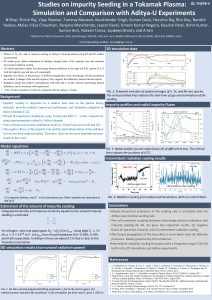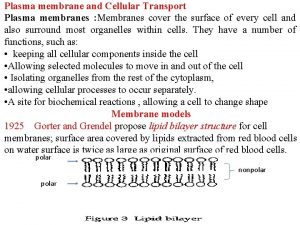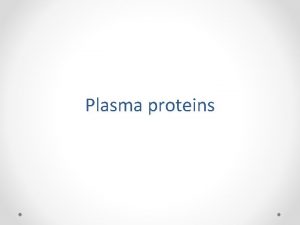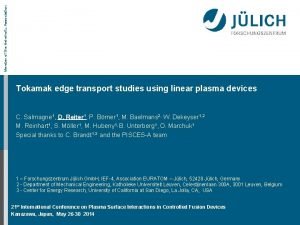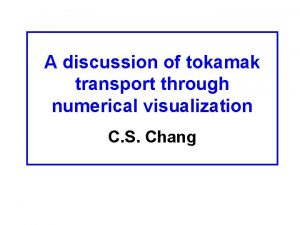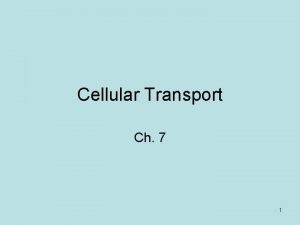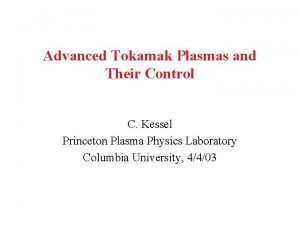RF Control of Tokamak Plasma Transport P Kaw






















































- Slides: 54

RF Control of Tokamak Plasma Transport P. Kaw, R. Singh and V. Tangri Institute for plasma Research, Bhat Gandhinagar-382 428, India.

Key Issue and Objective Transport in tokamaks is determined by drift like modes driven by pressure gradients and promoted by bad curvature of field lines. The key instabilties are : (1) ITG / ETG : confinement zone (2) DRBM : edge (3) CWI : ` SOL By actively controlling these modes, one can very significantly modify the confinement properties of a tokamak plasma.

One may cut down on anomalous transport by : Finding an appropriate parameter space of operation , say L-H mode transition ; here self consistent turbulent processes generate zonal flows with velocity shear that cut down the radial correlation length of turbulence. This reduces the step size for turbulent transport. Like JUDO Stabilizing the key instabilities by changed configuration such as in the R-S (reversed shear mode) of operation External intervention such as by biased limiters/ divertors / Probes , changed profiles using pellets, molecular beams etc HERE WE DISCUSS EXTERNAL INTERVENTION BY RF FIELDS

RF fields may be used to control transport in many ways By stabilizing the key instabilities using ponderomotive force of RF fields to oppose effects due to bad curvature of field lines (similar to Sen and Kaw 1986 for ideal ballooning modes ) By introducing zonal flows with velocity shear with the help of RF fields ( Ono et al 1991, Craddock and Diamond 1991) By controlling test particle transport due to turbulence by Chaos control methods ( Ciraolo et al 2004 ) We discuss first topic in some detail and then offer a few comments on the other two methods.

RF and FUSION Early days of fusion research RF considered as tool for plasma confinement. Typically Required RF pressure ~ Plasma pressure Abandoned because RF fields required were too large and led to intense nonlinear dissipative effects. RF extensively used now for heating and current drive RF pressure successfully used for end plugging experiments in mirrors. Proposed for stabilizing ideal MHD instabilities in toroidal devices ( Ballooning Modes Sen and Kaw 1986 , External kink modes D’ Ippolito et al 1987 ). Fields required small. Typically , gravitational curvature effects balanced by ponderomotive force effects giving RF pressure / Plasma Pressure ~ Lrf / R << 1

We discuss the effects of mean radial ponderomotive pressure set-up by RF waves on the important tokamak transport Can RF waves can prevent or modify candidates, which have growth rates dominated release of free energy associated bythe magnetic curvature with “bad magnetic curvature” ? (i)DRBM, (ii) curvature driven CWI in the SOL (iii) ITG modes,

BASIC EQUATIONS - I The ion continuity equation is an additional equilibrium ion poloidal drift due to radial ponderomotive force setup by externally launched RF waves; here defined on the next slide Is

Ponderomotive Force Expression for ponderomotive force in a cold magnetized plasma (Karpman and Shaglov 1982, Lee and Parks 1983); Where are the elements of the cold plasma conductivity tensor. Thus

BASIC EQUATIONS - II The plasma momentum equation radial ponderomotive force due to RF waves experienced by ion and electron fluids dissipation; neoclassical damping / viscous damping

BASIC EQUATIONS - III The ion energy equation the ion diamagnetic heat flow

Miscellany magnetic field (in a sheared slab approximation) Normalized Electrical conductivity

Continuity equation Ion energy equation In these two Equations, the RF field enters only through the ponderomotive ion drift term.

Vorticity Equation ( ) In this Equation, RF fields enter through the ponderomotive drift term and the divergence of the perpendicular current due to both ions and electrons.

LINEAR THEORY We take the perturbed fluctuation fields

Linear Ballooning Representation • In the ballooning representation parallel wave vector • , the perpendicular wave vector: • Where is the poloidal mode number r is a radius of the plasma, tokamak. is the major radius of

Drift Resistive Ballooning Mode Dispersion relation where Note that here for simplicity we have neglected the effect of ion temperature perturbation.

Is the RF Parameter where

Special Limiting Cases with (relevant for the edge of takamak plasma) is: In the limiting case where collisions are important ( ) and

Stabilizing Effects of RF - I

Stabilizing Effects of RF - II

Stabilizing Effects of RF - III

Stability Condition Without FLR effects stabilization, the necessary stability condition for DRBM:

Conducting Wall Instability We now consider the stability of SOL, which is well known to be unstable to low frequency perturbations like the curvature driven conducting wall instability (CWI)* *H. L. Berk, D. D. Ryutov, and Yu. A. Tsidulko, Phys. Fluids B 3, 1346 (1991). X. Garbet, L. J. -P. Laurent, A. Samain, Nucl. Fusion 31, 967 (1991). N. Chakrabarti, A. Das, S. Deshpande, P. K. Kaw, S. Mahajan, A. Sen, and R. Singh, IAEA-CN-60/D-9

The basic equations describing these low frequency fluctuations in the SOL are similar to our previous discussion ; in addition, the parallel current perturbations are expressed by the Bohm sheath criterion. For Maxwellian plasma, the equilibrium plasma current near the sheath

In case when the limiter/divertor is floating, the equilibrium results in a simple relation between and , • For , the expression for parallel current perturbation

A simple dispersion relation of curvature driven CWI compression of the polarization drift magnetic curvature term perturbation in parallel current drawn to limiter A. V. Nedospasov, Fiz. Plazmy 15, 1139 (1989); A. V. Nedospasov, Phys. Fluids B 5, 3191 (1993).

• For and small ion polarization drift effects (i. e. ), we get

Special Limiting Cases : CWI If the ion polarization current perturbation dominates over the parallel current perturbation in the (i. e. , ), then the growth rate of ideal interchange (ideal drift ballooning) mode is given by S. V. Novakovskii, P. N. Guzdar, J. F. Drake and C. S. Liu, Phys. Plasmas 2, 3764 (1995).

Stability Condition for CWI For , and, the stability condition for CWI with RF effects is:

Toroidal ITG Mode For the ITG mode, the vorticity equation plays a subsidiary role, typically showing that follow the Boltzmann relation It is only in the collisional limit, that RF fields enter the ITG problem in a significant manner

Toroidal ITG Mode • We derive dispersion relation of ITG mode in a collisional regime: Under these conditions, the electrons are not free to move along the field lines and they follow the modified Boltzmann relation : where

ITG Mode: Dispersion Relation (diamagnetic drift frequency )

Treating the RF ponderomotive term perturbatively …… ( when and small) where The effect is therefore stabilizing ! are

Particle Flux An interesting consequence of RF waves on the collisional ITG mode is the non-adiabatic electron response which can result in a particle pinch effect particle diffusion coefficient estimated from mixing length theory

Conclusions: ITG In conclusion, the effect of RF ponderomotive pressure is shown to be stabilizing on the collisional, toroidal ITG mode. Furthermore, a noteworthy effect of RF ponderomotive pressure on ITG mode in the collisional regime is the creation of an inward particle flux.

How to apply RF fields to tokamak plasma. Objective : to create a ponderomotive force in opposite direction to “effective gravity” due to bad curvature of field lines. Requires RF waves coming in from outside and radially in the cut off regime so that the fields on the outer surfaces are stronger than the fields inside. Ponderomotive pressure may be applied on electrons or ions and is effective in both cases because of vorticity equation where both enter.

High Frequency Electron Modes The simplest mode to consider is the perpendicularly propagating O mode which has a cut – off at In the cut-off regime it has a radial decay length of the order of. The position and magnitude of the ponderomotive force due to this mode can thus be adjusted at will. Furthermore , using the quasi transverse propagation dispersion relation valid when we can give this mode enough the magnetic surfaces. so that it spreads over

Electron Modes - II The X mode of propagation for which the cut-offs exist at: is an equally interesting candidate.

Lower Hybrid Waves Intermediate frequency waves extensively used for heating and current drive in tokamaks. May be used for transport control in the very edge or scrape off region. Dispersion relation for electrostatic lower hybrid waves shows that the waves are cut off when plasma density is less than that given by This requires and is possible only in the scrape off layer. The transverse scale of the fields is of order

Ion Cyclotron Range of Frequencies Also extensively used for heating and current drive in tokamaks. One typically uses the fast mode in the minority heating regime. In this case the dispersion relation may be approximated as where

Center

We can adjust the position of R and L cut offs by changing the plasma parameters. Thus radially decaying profiles can be set up in the edge as well as in the core region. In the latter case a significant part of the wave will be used up in minority heating and so heating and transport control could be accomplished together.

In all the cases considered complete stabilization requires Ve 2 / Ce 2 + Vi 2 / Ci 2 > Lrf / R Even below this amplitude of the applied rf field significant reduction of growth rate of instability and resultant transport may be possible. For reactor grade plasmas this translates into a requirement of RF power ~10 Megawatts. At these amplitudes other nonlinear effects due to rf fields such as parametric excitation of unwanted modes and the resultant dissipation/ contribution to transport may have to be seriously looked into. Experiments possible with existing equipments on large devices and can be carried out to look at the possible regimes of interest , problems encountered etc.

Comparison With Other RF Transport Control Methods Craddock and Diamond (1991) have proposed creating velocity shear in tokamaks using ponderomotive forces due to RF fields. This velocity shear is then used to stabilize unwanted instabilities in a manner similar to self consistent zonal flow effect. They consider ponderomotive forces in poloidal direction and balance them against neoclassical damping forces of the poloidal rotation and get a flow shear of order

RF INDUCED VELOCITY SHEAR As an approximate criterion when the flow shear exceeds the linear growth rate of the mode one expects significant stabilization effects ; for the curvature induced instabilities it gives a requirement This may be compared with the requirement from our method which goes as

Experiments on RF Transport Control Ono et al (1993) have carried out experiments in PBX M tokamak where significant improvement of confinement and sharpening of ion temperature profiles with heating by ion Bernstein modes ( P rf ~ 0. 2 Mwatts ). Craddock and Diamond (1993)have interpreted these experiments from their theory. Unambiguous identification of the mechanisms is however , uncertain because of major self consistent changes in basic tokamak equilibrium which also gives possiblity of flows, possible L-H transition etc. There also plasma regions where RF leads to deterioration of plasma confinement and flattening of temperature profiles , which cannot be explained. Preliminary comparison shows that our results on radial ponderomotive force effects also consistent with measurements.

HAMILTONIAN CHAOS CONTROL Ciraolo et al (2004) have considered use of Chaos control methods for reduction of anomalous transport due to magnetized plasma turbulence. They consider test particle motion in a magnetized plasma with low frequency drift like electrostatic two dimensional potential fields. Equations are Eqs. have an obvious Hamiltonian structure. The remarkable feature is that even when the spatial patterns of the electric fields are quite regular the charged particles can rapidly diffuse across magnetic fields with an intense noncollisional intrinsic diffusion.

From Ciraolo et. al. 69 056213 (2004)

CHAOS CONTROL II Ciraolo et al (2004) have suggested addition of external fields with specific phases and amplitudes which distort the original Hamiltonian sufficiently such that the distorted Hamiltonian has much better trajectories. By a smart choice of the perturbing fields it is shown that even when these fields are small ( of order ε 2 compared to original fields of order ε giving chaotic trajectories ), they can very significantly improve the trajectories , substantially reducing the diffusion coefficient

From Ciraolo et. al. 69 056213 (2004)

CHAOS CONTROL - ISSUES The method relies on applying drift like rf fields to the particles undergoing transport. The amplitudes and phases of the given fields have to have specific values although it is shown that the method is robust to approximations in the implementation scheme. Application of drift wave like frequencies (50 -100 KHz ) externally is practical directly only in the scrape off or edge region where the plasma is accessible by probes which may introduce local sources/sinks of particles and/or local bias on the lines.

CHAOS CONTROL - ISSUES Note what we apply is strongly modified by plasma response and one has to learn how to manipulate the combination to get the desired fields. In the plasma interior one will have to create the desired fields by nonlinear mixing of higher frequency carrier fields which can readily propagate into the interior. Method relies on improving test particle transport by external fields. Question of modification of self consistent transport in which the diffusing particles significantly influence the fields diffusing them remains open.

Conclusions Radial Ponderomotive forces may be used to weaken or stabilize the curvature driven instabilities giving transport in toroidal devices. Method relies on prevention of extraction of “gravitational” free energy by providing rf support. Therefore control does not depend on detailed phase information of excited waves which is very difficult to use when there is broadband turbulence. Have shown how to implement it with electron cyclotron , lower hybrid and ion cyclotron waves. Typical powers required for large experiments are in 1 -10 MWatt range. Proof of principle experiments could be attempted at much smaller powers ( 10 -100 kilowatt range) in small devices like BETA , BLAMANN , ADITYA etc

RF methods may also be used to control anomalous transport by the introduction of velocity shear due to ponderomotive force introduced flows. Similar powers as described above are required. Lastly RF fields around the drift frequencies may be used to directly influence the test particle trajectories and reduce the anomalous transport. In all these cases experiments are required to see the effectiveness of the method and to investigate any deleterious effects which may accompany the transport improvement.
 Tokamak golem
Tokamak golem Tokamak
Tokamak Fuzn
Fuzn Tokamak működése
Tokamak működése Tokamak
Tokamak Tokamak hl-2m
Tokamak hl-2m Tokamak
Tokamak Equation of motion
Equation of motion Hl2 tokamak
Hl2 tokamak Autar kaw
Autar kaw Autar kaw
Autar kaw Autar kaw
Autar kaw Newtons second kaw
Newtons second kaw Newtons second kaw
Newtons second kaw Autar kaw
Autar kaw Autar kaw
Autar kaw Autar kaw
Autar kaw Autar kaw
Autar kaw Autar kaw
Autar kaw Autar kaw
Autar kaw Autar kaw
Autar kaw Autar kaw
Autar kaw Autar kaw
Autar kaw Autar kaw
Autar kaw Autar kaw
Autar kaw Euler method
Euler method Autar kaw
Autar kaw Autar kaw
Autar kaw Autar kaw
Autar kaw Autar kaw
Autar kaw Autar kaw
Autar kaw Autar kaw
Autar kaw Autar kaw
Autar kaw Autar kaw
Autar kaw Autar kaw
Autar kaw Symport antiport uniport
Symport antiport uniport Active transport
Active transport Passive transport vs active transport venn diagram
Passive transport vs active transport venn diagram Active transport vs passive transport venn diagram
Active transport vs passive transport venn diagram Unlike passive transport, active transport requires *
Unlike passive transport, active transport requires * Primary active transport vs secondary active transport
Primary active transport vs secondary active transport Bioflix activity membrane transport active transport
Bioflix activity membrane transport active transport Active transport image
Active transport image Bioflix membrane transport
Bioflix membrane transport Serum is plasma minus
Serum is plasma minus How do plasma particles move
How do plasma particles move Deby length
Deby length Plasma modeling software
Plasma modeling software Glomerular capillary pressure
Glomerular capillary pressure State of matter
State of matter Trali symptoms
Trali symptoms Fresh frozen plasma vs platelets
Fresh frozen plasma vs platelets Plasma state of matter examples
Plasma state of matter examples Plasma equation
Plasma equation Plasma particles
Plasma particles
